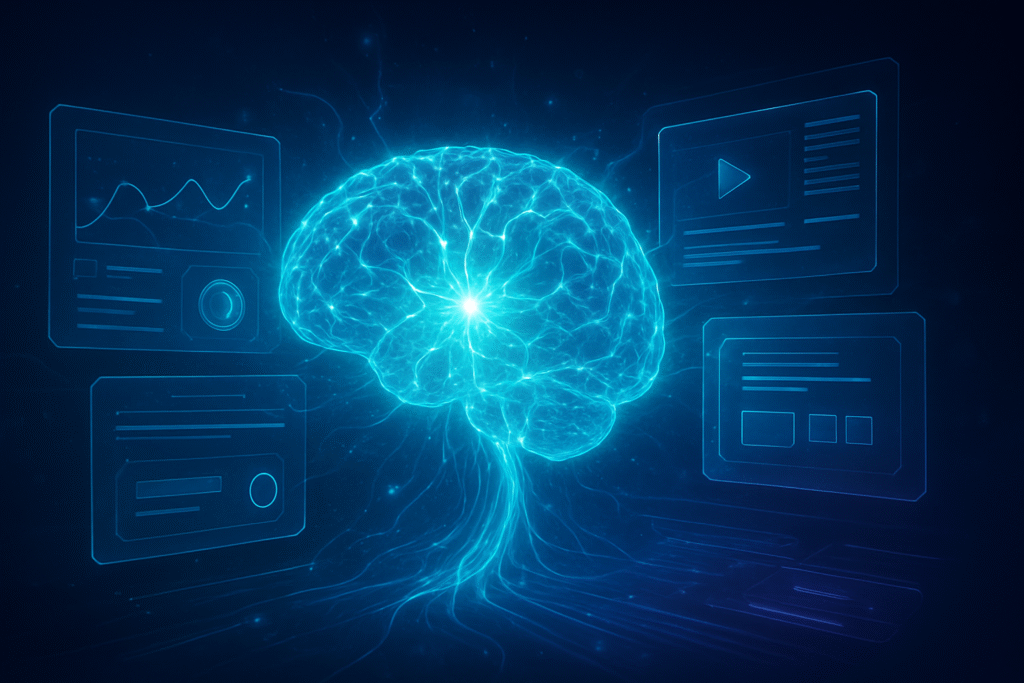
In a monumental leap forward for artificial intelligence, Google (NASDAQ: GOOGL) has officially rolled out a groundbreaking update to its Gemini AI, introducing a revolutionary feature known as Generative UI (User Interface) or Generative Interfaces. Announced on November 18, 2025, alongside the release of Gemini 3 and its advanced models, Gemini 3 Pro and Gemini 3 Deep Think, this innovation empowers AI to dynamically construct entire user experiences, including interactive web pages, games, tools, and applications, in direct response to user prompts. This development signifies a profound shift from static content generation to the real-time creation of bespoke, functional interfaces, promising to redefine how humans interact with digital systems.
The immediate significance of Generative UI is difficult to overstate. It heralds a future where digital interactions are not confined to pre-designed templates but are instead fluid, intuitive, and uniquely tailored to individual needs. This capability not only democratizes access to sophisticated creative and analytical tools but also promises to dramatically enhance productivity across a myriad of workflows, setting a new benchmark for personalized digital experiences.
The Dawn of Dynamic Interfaces: Technical Underpinnings and Paradigm Shift
At the heart of Google's Generative UI lies the formidable Gemini 3 Pro model, augmented by a sophisticated architecture designed for dynamic interface creation. This system grants the AI access to a diverse array of tools, such as image generation and web search, enabling it to seamlessly integrate relevant information and visual elements directly into the generated interfaces. Crucially, Generative UI operates under the guidance of meticulously crafted system instructions, which detail goals, planning, examples, and technical specifications, including formatting and error prevention. These instructions ensure that the AI's creations align precisely with user intent and established design principles. Furthermore, post-processors refine the initial AI outputs, addressing common issues to deliver polished and reliable user experiences. Leveraging advanced agentic coding capabilities, Gemini 3 effectively acts as an intelligent developer, designing and coding customized, interactive responses on the fly, a prowess demonstrated by its strong performance in coding benchmarks like WebDev Arena and Terminal-Bench 2.0.
This approach represents a fundamental departure from previous AI interactions with interface design. Historically, AI systems primarily rendered content within static, predefined interfaces or delivered text-only responses. Generative UI, however, dynamically creates completely customized visual experiences and interactive tools. This marks a shift from mere "personalization"—adapting existing templates—to true "individualization," where the AI designs unique interfaces specifically for each user's needs in real-time. The AI model is no longer just generating content; it's generating the entire user experience, including layouts, interactive components, and even simulations. For instance, a query about mortgage loans could instantly materialize an interactive loan calculator within the response. Gemini's multimodal understanding, integrating text, images, audio, and video, allows for a comprehensive grasp of user requests, facilitating richer and more dynamic interactions. This feature is currently rolling out in the Gemini app through "dynamic view" and "visual layout" experiments and is integrated into "AI Mode" in Google Search for Google AI Pro and Ultra subscribers in the U.S.
Initial reactions from the AI research community and industry experts have been overwhelmingly positive. Human evaluations have shown a significant preference for these AI-generated interfaces, with users strongly favoring generative UIs over standard language model outputs (97% preferred over text-only AI responses) and even over traditional websites (90% preference). Jakob Nielsen, a prominent computer-interface expert, has heralded Generative UI as the "third user-interface paradigm" in computing history, underscoring its potential to revolutionize human-computer interaction. While expert human-designed solutions still hold a narrow preference over AI-designed solutions in head-to-head contests (56% vs. 43%), the rapid advancement of AI suggests this gap is likely to diminish quickly, pointing towards a future where AI-generated interfaces are not just preferred, but expected.
Reshaping the AI Landscape: Competitive Implications and Market Disruption
Google's introduction of Generative UI through Gemini 3 is set to profoundly reshape the competitive landscape for AI companies, tech giants, and startups alike. Google (NASDAQ: GOOGL) stands to be a primary beneficiary, solidifying its position at the forefront of AI innovation and potentially gaining a significant strategic advantage in the race for next-generation user experiences. This development could substantially enhance the appeal of Google's AI offerings, drawing in a wider user base and enterprise clients seeking more intuitive and dynamic digital tools.
The competitive implications for major AI labs and tech companies are substantial. Rivals like OpenAI, Microsoft (NASDAQ: MSFT), and Meta Platforms (NASDAQ: META) will undoubtedly face pressure to develop comparable capabilities, potentially accelerating the arms race in generative AI. Companies focused on traditional web development, UI/UX design tools, and low-code/no-code platforms may experience significant disruption. Generative UI's ability to create functional interfaces from natural language prompts could reduce the reliance on manual coding and design, impacting the business models of companies that provide these services. Startups specializing in niche AI applications or those leveraging existing generative models for content creation could pivot to integrate or compete with generative UI, seeking to offer specialized dynamic interface solutions. This innovation also positions Google to potentially disrupt the market for digital product development, making sophisticated application creation more accessible and efficient, thereby lowering barriers to entry for new digital ventures.
Market positioning and strategic advantages will increasingly hinge on the ability to deliver truly individualized and dynamic user experiences. Companies that can effectively integrate generative UI capabilities into their platforms will gain a significant edge, offering unparalleled levels of personalization and efficiency. This could lead to a re-evaluation of product roadmaps across the industry, with a renewed focus on AI-driven interface generation as a core competency. The "navigation tax" of traditional interfaces, where users spend time finding features, is poised to be significantly reduced by AI-generated UIs that present only relevant components optimized for immediate user intent.
A Broader Significance: The Evolution of Human-Computer Symbiosis
The launch of Generative UI fits seamlessly into the broader AI landscape and current trends emphasizing more intuitive, agentic, and multimodal AI interactions. It represents a significant stride towards the vision of truly intelligent assistants that don't just answer questions but actively help users accomplish tasks by constructing the necessary digital environments. This advancement aligns with the growing demand for AI systems that can understand context, anticipate needs, and adapt dynamically, moving beyond mere information retrieval to active problem-solving and experience creation.
The impacts are far-reaching. For end-users, it promises a future of frictionless digital interactions, where complex software is replaced by fluid, context-aware interfaces that emerge on demand. For developers and designers, it introduces a new paradigm where AI acts as a "silent, super-intelligent design partner," capable of synthesizing feedback, suggesting design system updates, and even generating code from sketches and prompts. This could dramatically accelerate the design process, foster unprecedented levels of innovation, and allow human designers to focus on higher-level creative and strategic challenges. Potential concerns include the ethical implications of AI-driven design, such as algorithmic bias embedded in generated interfaces, the potential for job displacement in traditional UI/UX roles, and the challenges of maintaining user control and transparency in increasingly autonomous systems.
Comparisons to previous AI milestones underscore the magnitude of this breakthrough. While early AI milestones focused on processing power (Deep Blue), image recognition (ImageNet breakthroughs), and natural language understanding (large language models like GPT-3), Generative UI marks a pivot towards AI's ability to create and orchestrate entire interactive digital environments. It moves beyond generating text or images to generating the very medium of interaction itself, akin to the invention of graphical user interfaces (GUIs) but with an added layer of dynamic, intelligent generation. This is not just a new feature; it's a foundational shift in how we conceive of and build digital tools.
The Horizon of Interaction: Future Developments and Expert Predictions
Looking ahead, the near-term developments for Generative UI are likely to focus on refining its capabilities, expanding its tool access, and integrating it more deeply across Google's ecosystem. We can expect to see enhanced multimodal understanding, allowing the AI to generate UIs based on even richer and more complex inputs, potentially including real-world observations via sensors. Improved accuracy in code generation and more sophisticated error handling will also be key areas of focus. In the long term, Generative UI lays the groundwork for fully autonomous, AI-generated experiences where users may never interact with a predefined application again. Instead, their digital needs will be met by ephemeral, purpose-built interfaces that appear and disappear as required.
Potential applications and use cases on the horizon are vast. Imagine an AI that not only answers a complex medical question but also generates a personalized, interactive health dashboard with relevant data visualizations and tools for tracking symptoms. Or an AI that, upon hearing a child's story idea, instantly creates a simple, playable game based on that narrative. This technology could revolutionize education, personalized learning, scientific research, data analysis, and even creative industries by making sophisticated tools accessible to anyone with an idea.
However, several challenges need to be addressed. Ensuring the security and privacy of user data within dynamically generated interfaces will be paramount. Developing robust methods for user feedback and control over AI-generated designs will be crucial to prevent unintended consequences or undesirable outcomes. Furthermore, the industry will need to grapple with the evolving role of human designers and developers, fostering collaboration between human creativity and AI efficiency. Experts predict that this technology will usher in an era of "ambient computing," where digital interfaces are seamlessly integrated into our environments, anticipating our needs and providing interactive solutions without explicit prompting. The focus will shift from using apps to experiencing dynamically generated digital assistance.
A New Chapter in AI History: Wrapping Up the Generative UI Revolution
Google's Gemini 3 Generative UI is undeniably a landmark achievement in artificial intelligence. Its key takeaway is the fundamental shift from AI generating content within an interface to AI generating the interface itself, dynamically and individually. This development is not merely an incremental improvement but a significant redefinition of human-computer interaction, marking what many are calling the "third user-interface paradigm." It promises to democratize complex digital creation, enhance productivity, and deliver unparalleled personalized experiences.
The significance of this development in AI history cannot be overstated. It represents a crucial step towards a future where AI systems are not just tools but intelligent partners capable of shaping our digital environments to our precise specifications. It builds upon previous breakthroughs in generative models by extending their capabilities from text and images to interactive functionality, bridging the gap between AI understanding and AI action in the digital realm.
In the long term, Generative UI has the potential to fundamentally alter how we conceive of and interact with software, potentially rendering traditional applications as we know them obsolete. It envisions a world where digital experiences are fluid, context-aware, and always optimized for the task at hand, generated on demand by an intelligent agent. What to watch for in the coming weeks and months includes further announcements from Google regarding broader availability and expanded capabilities, as well as competitive responses from other major tech players. The evolution of this technology will undoubtedly be a central theme in the ongoing narrative of AI's transformative impact on society.
This content is intended for informational purposes only and represents analysis of current AI developments.
TokenRing AI delivers enterprise-grade solutions for multi-agent AI workflow orchestration, AI-powered development tools, and seamless remote collaboration platforms.
For more information, visit https://www.tokenring.ai/.


















